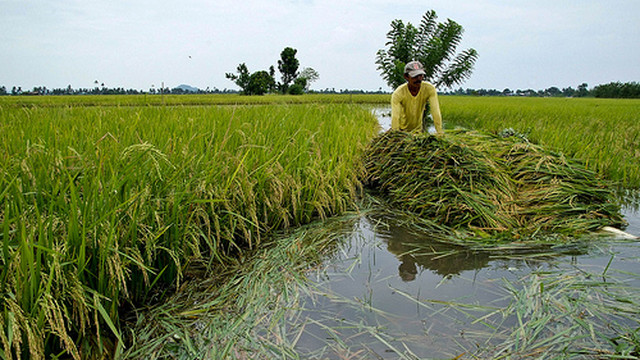SUMMARY
This is AI generated summarization, which may have errors. For context, always refer to the full article.

MANILA, Philippines – The world’s premiere rice research center will distribute flood-tolerant rice to farmers in areas devastated by Super Typhoon Yolanda (Haiyan).
The International Rice Research Institute (IRRI) based in Los Baños, Laguna said the rice variety “Scuba,” bred to survive floods, can help Leyte get back on its feet as a rice-producing province.
Leyte has more than 100,000 hectares of rice land. From 2000 to 2009, increase in its rice production was the 3rd highest in all provinces, after Nueva Ecija and Iloilo. It also has the highest average annual growth rate in terms of yield per hectare output.
Scuba rice can stay submerged under flood waters up to two weeks without damage. Locally called “Submarino” rice, it is one of many rice varieties developed by IRRI to withstand the effects of climate change. There are also developing drought-tolerant rice, rice that can stand salt water and rice that can survive in extremely hot or cold environments.
Though not a genetically-modified organism, scuba rice was developed through an advanced form of breeding called marker-assisted breeding. If traditional breeding required farmers to wait for a plant to grow to see if it would show desirable traits like flood resistance before breeding with another variety, this new technique allows scientists to detect the genes for desirable traits even before they are visible.
“It’s traditional breeding sped up by using advanced biotechnology methods,” Tolentino told Rappler.
Extensive losses
Thankfully, rice crops for the wet season were already harvested before the typhoon came, said Samarendu Mohanty, an IRRI economist.
Farmers were only preparing the dry season crop when Yolanda hit.
But agricultural infrastructure damage caused by storm surges was extensive. Storm surges – rises in sea level that causes sudden flooding – went as high as 17 feet in some areas, based on reports.
“The most serious issues will arise from extensive losses resulting from the storm surge — in farm machinery, storage, housing, and damage to roads and irrigation. These will need replacement and rehabilitation,” said Bruce Tolentino, IRRI deputy director general for communication and partnership.
“In the meantime, access to markets is constrained and household food stocks are down to zero, causing a spike in local food prices.”
But Agriculture Secretary Proceso Alcala gave assurances that government-owned food trading terminals are being used in the Visayas to avoid a spike in food prices. Main commodities like rice, chicken, vegetables and potatoes are also now being moved from production areas to the terminals to prevent price increases.
Damage to rice cultivation due to Yolanda has reached P1.2 billion, said Alcala. His department recorded a total of 137,225 metric tons (MT) of rice crops lost. Meanwhile, 81,056 hectares of rice fields were affected, and only half them can be recovered. (READ: Yolanda agri damage now at P6.9B) – Rappler.com
Add a comment
How does this make you feel?
There are no comments yet. Add your comment to start the conversation.